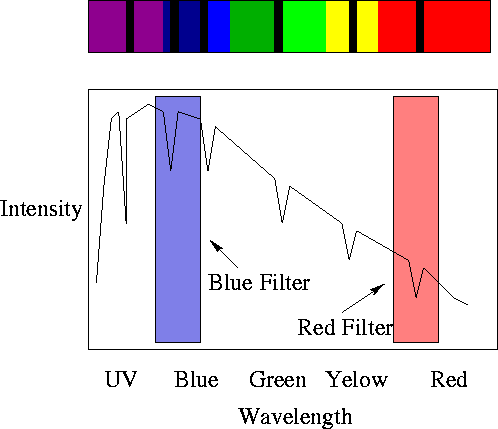Measuring Stellar Temperatures
- Ultra-cheap trick: "Say, that star looks a little bit
redder than the Sun so its surface temperature must be less than
5200K"
- Cheap Trick: Disperse the light from a star ("take a
spectrum") and find the wavelength at which you have the most
radiation then apply Wien's Law.
- One of the two ways it is really done - measure colors:
- For Planck spectra (from solid objects), the ratio of
the light in two different color filters unambiguously gives the
temperature of the objects.

Cooler objects will have redder colors. To the extent that
Stellar spectra look like blackbodies, the temperature of a
star can also be measured amazingly accurately by recording the
brightness in two different filters.
- This leads us to a good question: What do Stellar spectra
look like?
- In the 1800's the light from the Sun was dispersed and it
looked more-or-less like a Planck spectrum with some Missing Light
, or "absorption lines" at certain wavelengths.

It turns out that colors can still be used to measure stellar
temperatures, the relationship between color and surface temperature
is just a little more complicated and needs to be calibrated using
computer models.
To get a stellar temperature:
- Measure the brightness of a star through two
filters and compare the ratio of red to blue light
- Compare to the spectra of computer models of stellar spectra
of different temperature and develop an accurate
color-temperature relation
- Now, those wavelengths with missing light in a stellar spectrum
turned out to be very interesting and important. Their importance was
realized after Emission line spectra were discovered and
investigated by chemists.
- If a gas is heated to the point where it glows, the resulting
spectrum has light at discrete wavelengths that turn out to match the
wavelengths of missing light in stellar spectra.




